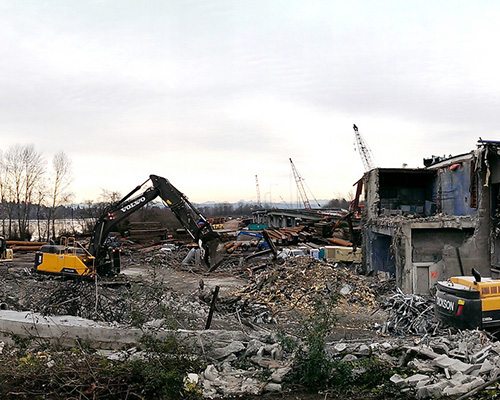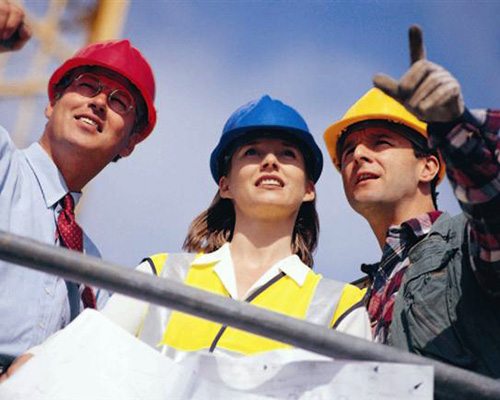
Deconstruction
Michael & Associates is dedicated to reducing waste by promoting deconstruction over demolition. In cities throughout the U.S., certified deconstruction contractors offer this critical alternative: in place of demolition’s swift, near-complete destruction of structures slated for removal, buildings are carefully dismantled and the highest possible percentage of materials salvaged for reuse.
WHY WE CARE & YOU SHOULD TOO
Through Michael & Associates efforts, 75 to 80 percent of a building can be kept out of the landfill.
The average wood-framed house in the U.S. contains between 30 and 40 pounds-per-square-foot of building materials. That means a 1,500 square-foot house contains between 22.5 and 30 tons of material, and a 2,000 square foot house has 30 to 40 tons.
Certified Deconstruction Contractors have deconstructed thousands of buildings, including hundreds of houses, apartment buildings, military warehouses and large scale motion picture sets, in the process salvaging or recycling over 250,000 tons that would otherwise have gone to local landfills.
WHAT WE SALVAGE
- framing lumber
- doors & windows
- cabinets
- flooring
- plumbing
- electric fixtures
and more…
Michael & Associates (MAI) is dedicated to keeping reusable building materials out of our landfills and diverting them to local, national, and international markets through our deconstruction services. We give tax donation receipts to people who give us their reusable building materials and distribute these materials through retail warehouses that are open to the public.
How does the homeowner benefit from deconstruction services?
The homeowner receives a tax donation for all the materials salvaged by Michael & Associates. The materials include lumber, doors, windows, carpeting, plumbing and electrical fixtures, appliances, hardwood flooring, etc. Further, the materials salvaged reduces the homeowners cost of disposal and any tax benefit reduces the overall project costs.
What is the process of donation and deconstruction?
There are several steps, but all are very straight forward. Assuming the value of the materials in your house is over $5,000, the IRS requires you to have third party independent appraisal of their value. MAI will send you a list of independent appraisers who are qualified and have appraised the value of materials for our former donors. You will then hire Michael & Associates to deconstruct your house and deliver all salvaged materials to us. We prepare complete inventories on the materials salvaged and send them to your appraiser. The appraiser then prepares IRS form 8283 with the final value of the materials listed on the form and sends it to you. You attach this form to your 1040 when you file next year.
How long does it take?
Typically, a contractor can deconstruct between 700 and 1,000 square feet per week.
Where do the materials go?
All materials are delivered to rehab centers and warehouses across the country. From there they are either sold to the general public, shipped to low income markets in foreign countries, or donated to other nonprofit agencies.
Have any of your donors been audited by the IRS?
No.
Are these rehab stores open to the public?
Absolutely! All warehouses are open to the public. So if you’re looking for some high quality, reusable building materials, go see them.
How much does it cost to deconstruct a house?
The cost of deconstruction varies depending upon the materials used to build the house in the first place. Further, the costs are dependent on the location of the house, the local landfill costs for the actual debris generated from deconstruction, the contour of the site as well as and ease or difficultly of getting to it. However, Michael & Associates will provide free quotations for deconstruction.
How much of a write-off can I get for my house?
Only an appraiser can answer that question. Therefore we have a policy of not estimating any potential donation. However, if you go to www.michaelbuilt.com, and click on “What We Do” and click on the tab “Deconstruction” you will see a cost comparison between deconstruction and typical smash and dash demolition. Better yet, call an independent appraiser.
Is this a tax credit?
No, it is a tax donation. A tax credit is a one-for-one credit against the taxes you owe. A donation is a deduction just like a monetary donation to your church or a scouting organization.
Where can I get more information about tax donations?
MAI always recommends that you consult your professional tax preparer on the deductibility of any donation. You may also go the IRS website.
I’m a contractor, can I get a donation from the materials I remove form my customer’s house?
No. In technical terms, you have no basis in the materials. In other words you did not pay for them. However if you, like most contractors, have purchased materials then these would qualify for a donation if you were to donate them to us. That is because you have purchased them (you have basis in them).
I do not know any of the appraisers on the list that you provided. Who would you recommend?
All the appraisers on that list are IRS Qualified and are competent to provide you with the type of donation appraisal and reports required. It would be unprofessional of us to recommend one over the other.
What is the cost of an appraisal?
The appraisers are independent of the deconstruction process and we do not know what they charge.
BENEFITS
In addition to being a Green Initiative, deconstruction offers a variety of benefits for building owners, architects and developers.

Building owners, whether residential, commercial or industrial, rely heavily on the practical advice they receive for their building projects – advice concerning efficient and effective products, cost-saving methods, and ongoing maintenance. One decision that building owners often overlook involves how to dispose of existing materials during demolition. While demolition is only one aspect in the scope of the typical building project, it offers many opportunities for you, the owner to improve on existing practices and provide yourself with financial benefits. Think of it as “going green” — not once, but twice!
Unlike most green building practices that have high initial costs, expenses associated with deconstruction is often recouped by the owner immediately upon tax filing. Michael & Associates is dedicated to diverting reusable building materials from the waste stream and providing owners with generous tax-deductible donation receipts. When you choose deconstruction, you will thank us twice for going green – once now, and again at tax time.
We accomplish this goal through:
- Building deconstruction and materials salvage.
- Providing “best practices” training in deconstruction.
- Distributing salvaged materials and encouraging sustainable reuse.
- Writing demolition/deconstruction specifications for large and small projects.
By incorporating deconstruction and building-materials salvage, you demonstrate concern for the environment, as well as for your budget, by ensuring:
- Lower disposal costs
- Tax deductions based on the owner’s donation of materials
- Reduced carbon footprint
- Optional reuse of salvaged materials in the new project

Building owners, whether residential, commercial, or industrial have always turned to architects for innovative and cost effective design, materials and methods of construction. Demolition practices, including salvage and the handling of hazardous materials and demolition debris (C&D) are no exceptions. Unlike most green building practices that have high initial costs, expenses associated with deconstruction are often recouped by the owner immediately upon tax filing.
Because of recent federal, state and local legislation, traditional C&D disposal has changed dramatically. While demolition is only one aspect in the scope of a typical building project, it offers many opportunities for you, the architect, to improve on existing practices and provide your clients with financial benefits.
Michael & Associates is dedicated to diverting reusable building materials from the waste stream and providing owners with generous tax-deductible donation receipts. And remember: when you choose deconstruction, your clients will thank you twice — now, and again at tax time.
We accomplish this goal through:
- Building deconstruction and materials salvage.
- Providing “best practices” training in deconstruction.
- Distributing salvaged materials and encouraging sustainable reuse.
- Writing demolition/deconstruction specifications for large and small projects.
- Acting as project managers for large scale deconstruction/demolition projects, thus ensuring proper handling of C&D materials and access to reuse markets.
Including deconstruction in the planning phase of every project will help ensure:
- Additional time for deconstruction
- Lower disposal costs
- Tax deductions based on the owner’s donation of materials
- Reduced carbon footprint
- Optional reuse of salvaged materials in the new project

Real estate developers, whether residential, commercial or industrial, regularly face the problem of clearing unwanted structures from parcels slated for development. Until now, such structures represented a liability as well as an expense to the developer.
Furthermore, pledging to keep hundreds or thousands of tons of reusable building materials out of local landfills can enhance your project’s chances of approval and shorten the planning and permitting process. In the meantime, the community’s positive response to your environmental efforts can significantly leverage marketing dollars.
Michael & Associates has a program that can potentially turn every structure into a sizeable tax-deductible donation. We are dedicated to diverting reusable building materials from the waste stream. Our deconstruction methods and reuse distribution systems are compatible with local or state green-building guidelines and, if LEED certification is a goal, can earn the project from two-to-five points before construction even begins.
We accomplish this goal through:
- Building deconstruction and materials salvage.
- Providing “best practices” training in deconstruction.
- Distributing salvaged materials and encouraging sustainable reuse.
- Writing demolition/deconstruction specifications for large and small projects.
Through deconstruction and building-materials salvage, you demonstrate concern for the environment, and in addition:
- Lower disposal costs
- Receive tax-deductible donation receipts
- Reduce your carbon footprint
- Secure the option of reusing salvaged materials in the new development
One final thought: If a tax deduction is of little interest to you, consider offering it to the individual or organization from whom you are buying the property. By suggesting that the owner complete the deconstruction before the property transfers, you can sweeten your offer with no additional cost and increase your chances of beating the competition.

